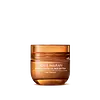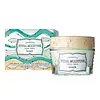What's inside
What's inside
 Key Ingredients
Key Ingredients

 Benefits
Benefits

 Concerns
Concerns

 Ingredients Side-by-side
Ingredients Side-by-side

Water
Skin ConditioningArgania Spinosa Kernel Oil
EmollientGlyceryl Stearate
EmollientGlycerin
HumectantCetyl Alcohol
EmollientButyrospermum Parkii Butter
Skin ConditioningDicaprylyl Carbonate
EmollientEthylhexyl Palmitate
EmollientHydroxyethyl Acrylate/Sodium Acryloyldimethyl Taurate Copolymer
Emulsion StabilisingCaprylic/Capric Triglyceride
MaskingXylitylglucoside
HumectantAloe Barbadensis Leaf Juice
Skin ConditioningAnhydroxylitol
HumectantSodium Stearoyl Glutamate
CleansingSqualane
EmollientXylitol
HumectantGlyceryl Caprylate
EmollientPolysorbate 60
EmulsifyingStearic Acid
CleansingGlyceryl Undecylenate
EmollientCucumis Sativus Fruit Extract
EmollientXanthan Gum
EmulsifyingCitric Acid
BufferingLysolecithin
EmulsifyingTocopherol
AntioxidantCitrullus Lanatus Fruit Extract
Skin ConditioningPhenoxyethanol
PreservativeSclerotium Gum
Emulsion StabilisingEthylhexylglycerin
Skin ConditioningAllantoin
Skin ConditioningPotassium Sorbate
PreservativeSodium Phytate
Panthenol
Skin ConditioningSodium Hyaluronate
HumectantPullulan
Water, Argania Spinosa Kernel Oil, Glyceryl Stearate, Glycerin, Cetyl Alcohol, Butyrospermum Parkii Butter, Dicaprylyl Carbonate, Ethylhexyl Palmitate, Hydroxyethyl Acrylate/Sodium Acryloyldimethyl Taurate Copolymer, Caprylic/Capric Triglyceride, Xylitylglucoside, Aloe Barbadensis Leaf Juice, Anhydroxylitol, Sodium Stearoyl Glutamate, Squalane, Xylitol, Glyceryl Caprylate, Polysorbate 60, Stearic Acid, Glyceryl Undecylenate, Cucumis Sativus Fruit Extract, Xanthan Gum, Citric Acid, Lysolecithin, Tocopherol, Citrullus Lanatus Fruit Extract, Phenoxyethanol, Sclerotium Gum, Ethylhexylglycerin, Allantoin, Potassium Sorbate, Sodium Phytate, Panthenol, Sodium Hyaluronate, Pullulan
Water
Skin ConditioningDicaprylyl Carbonate
EmollientHydrogenated Lanolin
EmollientSqualane
EmollientGlycerin
HumectantMethyl Trimethicone
Skin ConditioningGlyceryl Stearate
EmollientStearyl Alcohol
EmollientPEG-8
HumectantPentylene Glycol
Skin ConditioningCaprylic/Capric/Succinic Triglyceride
EmollientCeteth-20
CleansingEthylhexyl Palmitate
EmollientDimethicone
EmollientBetaine
HumectantDecyloxazolidinone
AntimicrobialPhenoxyethanol
PreservativeCetyl Alcohol
EmollientPalmitic Acid
EmollientStearic Acid
CleansingParfum
MaskingSteareth-25
CleansingMangifera Indica Seed Butter
Skin ConditioningSteareth-21
CleansingTetrasodium EDTA
Tocopheryl Acetate
AntioxidantCarbomer
Emulsion StabilisingXylitylglucoside
HumectantSorbitol
HumectantLinalool
PerfumingAnhydroxylitol
HumectantSodium Hydroxide
BufferingAlgin
MaskingXylitol
HumectantHexyl Cinnamal
PerfumingLimonene
PerfumingPolyvinyl Alcohol
Cellulose Gum
Emulsion StabilisingTocopherol
AntioxidantBHT
AntioxidantWater, Dicaprylyl Carbonate, Hydrogenated Lanolin, Squalane, Glycerin, Methyl Trimethicone, Glyceryl Stearate, Stearyl Alcohol, PEG-8, Pentylene Glycol, Caprylic/Capric/Succinic Triglyceride, Ceteth-20, Ethylhexyl Palmitate, Dimethicone, Betaine, Decyloxazolidinone, Phenoxyethanol, Cetyl Alcohol, Palmitic Acid, Stearic Acid, Parfum, Steareth-25, Mangifera Indica Seed Butter, Steareth-21, Tetrasodium EDTA, Tocopheryl Acetate, Carbomer, Xylitylglucoside, Sorbitol, Linalool, Anhydroxylitol, Sodium Hydroxide, Algin, Xylitol, Hexyl Cinnamal, Limonene, Polyvinyl Alcohol, Cellulose Gum, Tocopherol, BHT
 Reviews
Reviews

Ingredients Explained
These ingredients are found in both products.
Ingredients higher up in an ingredient list are typically present in a larger amount.
This ingredient is created from dehydrating xylitol in acidic conditions. Xylitol is a famous sugar and humectant.
Much like its predecessor, anhydroxylitol is a humectant. Humectants attract and hold water to moisturize the skin.
This ingredient is most commonly found in a popular trio called Aquaxyl. Aquaxyl is made up of anhydroxylitol (24 - 34%), xylitylglucoside (35 - 50%), and xylitol (5 - 15%).
According to a manufacturer, Aquaxyl is known for a 3-D hydration concept and an anti-dehydration shield to reinforce the outer layer of skin.
This ingredient is often derived from plants such as wood and sugarcane.
Learn more about AnhydroxylitolCetyl Alcohol is a fatty alcohol. Fatty Alcohols are most often used as an emollient or to thicken a product.
Its main roles are:
Though it has "alcohol" in the name, it is not related to denatured alcohol or ethyl alcohol.
The FDA allows products labeled "alcohol-free" to have fatty alcohols.
Learn more about Cetyl AlcoholDicaprylyl Carbonate comes from carbonic acid and caprylyl alcohol, a fatty alcohol. It is an emollient and gives skin a velvet feel. The sources of Dicaprylyl Carbonate may be synthetic or from animals.
As an emollient, Dicaprylyl Carbonate creates a film on the skin. This film traps moisture in, keeping your skin soft and hydrated.
Ethylhexyl Palmitate, also known as octyl palmitate, is created from 2-ethylhexyl alcohol and palmitic acid. It is a fatty acid ester.
The fatty acid content of Ethylhexyl Palmitate makes it an emollient. Emollients help soften and hydrate your skin by trapping moisture within.
Ethylhexyl Palmitate is also used to help improve the texture of cosmetics. It helps other ingredient dissolve in products and help disperse ingredients more evenly.
You'll likely find this ingredient in sunscreen, as it is often used to mix UV-blocking ingredients such as avobenzone and ethylhexyl triazone.
It can also help stabilize the fragrances in a product as a fragrance fixative.
Ethylhexyl Palmitate can be used to substitute mineral oil.
Due to its high fatty acid content, it may not be fungal-acne safe.
Learn more about Ethylhexyl PalmitateGlycerin is already naturally found in your skin. It helps moisturize and protect your skin.
A study from 2016 found glycerin to be more effective as a humectant than AHAs and hyaluronic acid.
As a humectant, it helps the skin stay hydrated by pulling moisture to your skin. The low molecular weight of glycerin allows it to pull moisture into the deeper layers of your skin.
Hydrated skin improves your skin barrier; Your skin barrier helps protect against irritants and bacteria.
Glycerin has also been found to have antimicrobial and antiviral properties. Due to these properties, glycerin is often used in wound and burn treatments.
In cosmetics, glycerin is usually derived from plants such as soybean or palm. However, it can also be sourced from animals, such as tallow or animal fat.
This ingredient is organic, colorless, odorless, and non-toxic.
Glycerin is the name for this ingredient in American English. British English uses Glycerol/Glycerine.
Learn more about GlycerinGlyceryl Stearate is a mix of glycerin and stearic acid.
It is used to stabilize the mixing of water and oil ingredients. By preventing these ingredients from separating, it can help elongate shelf life. It can also help thicken the product's texture.
As an emollient, it helps soften skin and supports barrier-replenishing ingredients.
In cosmetics, Glyceryl Stearate is often made from vegetable oils or synthetically produced.
This ingredient may not be fungal-acne safe
Fun fact: The human body also creates Glyceryl Stearate naturally.
Learn more about Glyceryl StearatePhenoxyethanol is a preservative that has germicide, antimicrobial, and aromatic properties. Studies show that phenoxyethanol can prevent microbial growth. By itself, it has a scent that is similar to that of a rose.
It's often used in formulations along with Caprylyl Glycol to preserve the shelf life of products.
Squalane is an emollient that helps the skin hold onto moisture. It's an oily liquid that occurs naturally in certain types of fish and plant oils.
Because squalane boosts hydration in the skin, it also comes with plenty of benefits: it is an antioxidant and can help fight free radicals and skin damage. Squalane is also found to have a detoxifying effect when applied.
Squalane comes from squalene, which occurs naturally within the sebum of our skin. It is one of the oils our skin produces to keep itself hydrated. Squalane is the hydrogenated version of squalene and has a longer shelf life.
Research shows that squalane is non-irritating (even at 100% concentration).
In general, it's a fantastic ingredient. It does a great job at hydrating the skin, and it's suitable for those with sensitive skin.
The source of squalane may impact malassezia / fungal acne. This is because olive oil derived squalane can contain impurities such as fatty acids and plant waxes. Sugarcane derived squalane is recommended for anyone with malassezia concerns.
Is squalane vegan?
This depends on the source. Squalane can be derived from both plants and animals. Most squalane used in skincare comes from plants.
Please note: the source of squalane is only known if disclosed by the brand. We recommend reaching out to the brand if you have any questions about their squalane.
Read more about squalene with an "e".
Is squalane an oil?
Squalane is often called an oil, but it’s technically not; it’s a hydrocarbon, meaning it’s only made of carbon and hydrogen, unlike true oils which are triglycerides made of fatty acids and glycerol.
The term “oil-free” isn’t regulated, so companies can define it however they want. Some exclude all oils, while others just avoid mineral oil or comedogenic oils.
While some people avoid oils thinking they cause breakouts, the right kind of oil (or oil-like ingredient like squalane) can actually help balance and hydrate your skin. It’s worth testing out simple oils or squalane to see what works best for your skin.
Learn more about SqualaneStearic Acid is a fatty acid. It is an emollient, emulsifier, and texture enhancer.
As an emollient, stearic acid helps soften skin. It aids the skin's protective barrier by preventing water loss. It also provides a gentle cleansing effect without stripping away natural oils.
Stearic acid may also be used to enhance the texture of products. It can add volume and stabilize ingredients such as water and oil. This can help water and oil ingredients from separating.
Sources of stearic acid include animal or vegetable fats/oils such as coconut or shea. It can be naturally found in butter, cocoa butter, shea butter, vegetable fats, and animal tallow.
This ingredient may not be Malassezia folliculitis, or fungal-acne safe.
Learn more about Stearic AcidTocopherol (also known as Vitamin E) is a common antioxidant used to help protect the skin from free-radicals and strengthen the skin barrier. It's also fat soluble - this means our skin is great at absorbing it.
Vitamin E also helps keep your natural skin lipids healthy. Your lipid skin barrier naturally consists of lipids, ceramides, and fatty acids. Vitamin E offers extra protection for your skin’s lipid barrier, keeping your skin healthy and nourished.
Another benefit is a bit of UV protection. Vitamin E helps reduce the damage caused by UVB rays. (It should not replace your sunscreen). Combining it with Vitamin C can decrease sunburned cells and hyperpigmentation after UV exposure.
You might have noticed Vitamin E + C often paired together. This is because it is great at stabilizing Vitamin C. Using the two together helps increase the effectiveness of both ingredients.
There are often claims that Vitamin E can reduce/prevent scarring, but these claims haven't been confirmed by scientific research.
Learn more about TocopherolWater. It's the most common cosmetic ingredient of all. You'll usually see it at the top of ingredient lists, meaning that it makes up the largest part of the product.
So why is it so popular? Water most often acts as a solvent - this means that it helps dissolve other ingredients into the formulation.
You'll also recognize water as that liquid we all need to stay alive. If you see this, drink a glass of water. Stay hydrated!
Learn more about WaterXylitol is a humectant and prebiotic. It can help with dry skin.
In studies, xylitol has been shown to improve dry skin. It decreased transepidermal water loss, or when water passes through the skin and evaporates. Xylitol also showed to help improve the biomechanical properties of the skin barrier.
The prebiotic property of xylitol may also help reinforce our skin's natural microbiome. Having a healthy microbiome prevents infection by bad bacteria and helps with hydration.
As a humectant, Xylitol helps draw moisture from both the air and from deeper skin layers. This helps keep skin hydrated.
Xylitol is a sugar alcohol and commonly used as a sugar substitute. It is naturally occurring in plants such as strawberries and pumpkin.
Learn more about XylitolXylitylglucoside is created from xylitol and glucose, two humectants.
Not surprisingly, this ingredient is also a humectant. It attracts and holds water in your skin, helping to maintain hydration.
This ingredient is most commonly found in a popular trio called Aquaxyl. Aquaxyl is made up of anhydroxylitol(24 - 34%), xylitylglucoside (35 - 50%), and xylitol (5 - 15%).
According to a manufacturer, Aquaxyl is known for a 3-D hydration concept and an anti-dehydration shield to reinforce the outer layer of skin.
Learn more about Xylitylglucoside